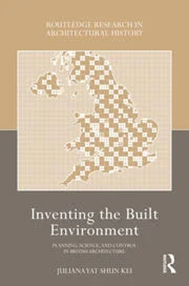
Wherever you are in the world and whatever you’re interested in, our ‘Books of the month’ features a broad sample of different recent releases authored by University of Liverpool staff. From architecture to business, photography to tourism, there’s something for everyone.
The University of Liverpool Library has curated a reading list for Book of the Month which is available and searchable for University of Liverpool staff and students. The newest titles are added at the top of the list for visibility and further information can be found in the notes area.
If you are a member of UoL staff and would like your new or recent (2023 or 2024) publication to be featured, please email the details to the Research Communications Team at rescomms@liverpool.ac.uk.
Inventing the Built Environment Planning, Science, and Control in British Architecture

By Juliana Yat Shun Kei
Published – June 2024
Why and how was the term ‘built environment’ first introduced? Inventing the Built Environment retrieves the origin of this ubiquitous term. The articulation of the ‘built environment,’ Kei demonstrates, coincided with the redefinition of education, research, and professional practices in architecture and town planning in 1960s Britain.
Concentrating on the half-decade during which the term permeated the architectural and planning professions, this book recalls a time when the ‘built environment’ was conceived as a part of the British government’s effort in national economic planning. Inventing the Built Environment unpacks the proposal for a Research Council for the Built Environment to mobilise architecture and town planning for political economy. How a relatively small group of architects, planners, politicians, and researchers transposed scientific thoughts from biology, economics, and computation into the ‘built environment’ will be considered, too. Kei highlights the assumptions about and classification of the population that were made when inventing the ‘built environment.’ The architectural and biosocial implications of the making and remaking of this architectural-environmental notion, in Britain and beyond, will be revealed through the works of pre-eminent architect-planners including Richard Llewelyn-Davies and William Holford.
At a time when environmental concerns again take the front seat of architectural and planning debates, this book offers, for scholars and students, an alternative lens to reflect on the assumptions and bias that can be embedded in our architectural lexicons.
***
Childhood in Liberal Theory
Equality, Difference, and Children’s Rights

By Nicolás Brando
British Academy Monographs
Published: July 2024
Children are systematically treated differently as political and legal subjects due to their assumed weaknesses, incapacities, and particular needs. How does this differential status fit in with the principles of justice that structure our society, law, and morality?
Despite the growth of philosophical research on childhood and children’s rights during the last decades, there has been no systematic study on the moral and political status of children in liberal political theory. Childhood in Liberal Theory fills this gap, and offers a novel look at the concept of ‘childhood’ and children’s rights within the tradition of liberal theories of justice. Brando proposes an ambitious deconstruction of the concept of ‘childhood’, and an Adaptive model of children’s rights as the most apt way of including children within liberal discourses on justice.
***
Essentials of Translational Pediatric Drug Development
From Past Needs to Future Opportunities

Editors: Elke Gasthuys, Karel Allegaert, Lien Dossche, Mark Turner
Published: July 2024
Essentials of Translational Pediatric Drug Development: From Past Needs to Future Opportunities provides integrated and up-to-date insights relevant for both translational researchers and clinicians active in the field of pediatric drug development. The book covers all key aspects from different stakeholder perspectives, providing a literature overview and careful reflection on state-of-the-art approaches. It will be an ideal guide for researchers in the field who are designing and performing high quality, innovative pediatric-adapted drug development by helping them define needs/challenges and possible solutions that advance and harmonize pediatric drug development.
Despite the broad consensus that children merit the same quality of drug treatment as any other age group, children remain frequently neglected during drug research and development. Even with the adoption of multiple legislations addressing this problem, the lack of efficacy and safety data of marketed as well as newly developed drugs still remain in the pediatric population.